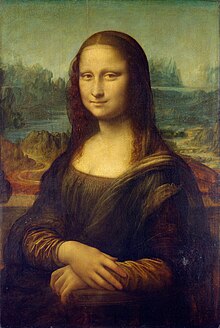
Leonardo da Vinci's Mona Lisa is one of the most recognizable and famous works of art in the world, and also one of the most replicated and reinterpreted. Mona Lisa studio versions, copies or replicas were already being painted during Leonardo's lifetime by his own students and contemporaries. Some are claimed to be the work of Leonardo himself, and remain disputed by scholars. Prominent 20th-century artists such as Marcel Duchamp and Salvador Dalí have also produced derivative works, manipulating Mona Lisa's image to suit their own aesthetic. Replicating Renaissance masterpieces continues to be a way for aspiring artists to perfect their painting techniques and prove their skills.[1]
Contemporary Mona Lisa replicas are often created in conjunction with events or exhibitions related to Leonardo da Vinci, for publicity. Her portrait, public domain and outside of copyright protection, has also been used to make political statements. Aside from countless print-reproductions of Leonardo's original Mona Lisa on postcards, coffee mugs and T-shirts, her likeness has also been re-imagined using coffee, toast, seaweed, Rubik's Cubes, and computer chips, to name only a few. Now over five-hundred years since her creation, the perpetuation of Mona Lisa's influence is reinforced with every reinterpretation.[2]